Ships are a principle means of transportation and recreation, and also a primary means of conducting warfare worldwide since ancient times. While military aircraft are new in human history, the warship has actually had more time to evolve. In more modern times, warships of exceptional scale, ingenuity, and design have arisen to intimidate and threaten opposing forces. Today, we discover the most awe-inspiring warships in world history in this high seas account…
10. Yamato-class: Yamato & Musashi

The Imperial Japanese Navy is known for unleashing some rather unsettling creations in the midst of World War II maritime conflict. Yet while “Bigger is Better” is admittedly associated with American military might and engineering achievements, it is less well known that shipbuilders in Japan went about creating some of the most impossibly massive and terrifying battleships the world has ever seen. The Yamato-class ships consisted of the namesake Yamato herself, and her sister ship the Musashi. The Yamato-class represented an enormous investment of battle resources in terms of materials, personnel, fuel, and armament in just two ships. These machines were the largest warships of all to be deployed during the Second World War.
With an enormous hull length stretching 863 feet, the Yamato-class was greater in size than all other battleships worldwide, with 20 percent more water displacement than any American vessel. The USS Iowa-class vessels were the only battleships longer than the Yamato-class ships, but this vessel was still less massive than the Yamato. Over 30 percent of the total weight of the ship was comprised by the steel armor assigned to the vessel, while the weaponry included the most massive guns in the history of warships. The main guns of the Yamato-class were the greatest in size placed on a warship, firing 18-inch diameter shells. The shells could be lobbed at an incredible range of 25 miles. Musashi was sunk on October 24, 1944 in the Battle of Leyte Gulf, while Yamato was sunk when intercepted on a mission to be run aground and fight to the end in defense of Okinawa on April 7, 1945.
9. USS Iowa-class

Named after an interior state with plenty of prairies, the USS Iowa-class might not come to mind at first thought when one is asked to name the most fearsome and all-around impressive battleship class in US Naval history. The largest battleships ever built by the United States, the members of the USS Iowa-class were not only the greatest in size among American warships, but it was the only one with the capability of firing nuclear shells. It remains a mystery whether the ships actually went into service while carrying nuclear shells, but the fact is the ships had 16-inch guns capable of launching them. Furthermore, nuclear shells specifically built for the guns on the Iowa-class ships were produced, leading to a very intimidating scenario indeed.
This class is clearly not a ship with which one could be advised to tangle! The USS Iowa herself served not only in the Pacific theater of World War II but also became involved in Korean War-related action. The ship was then decommissioned, recommissioned in 1984 to counter Soviet forces presenting concerns, decommissioned in 1990, and then recommissioned from 1999 to 2006 before being donated for museum exhibition. The vessel had the distinction of carrying president Franklin D. Roosevelt to a meeting in Tehran during World War II. The USS Iowa also bears a darker side to her history, notorious for killing 47 sailors as a result of a gun turret explosion in April 1989.
8. Caio Duilio-class ironclad
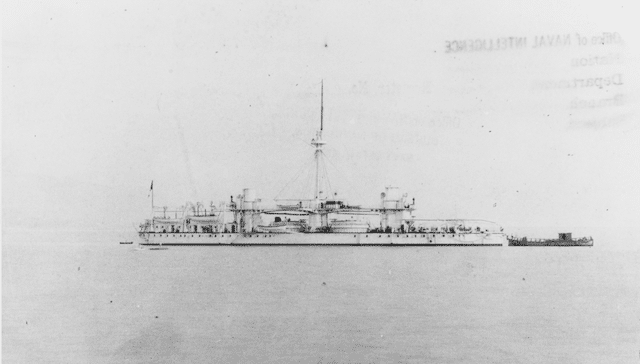
Italy might not be as well known as a country with a history as a leader in exceptional naval innovation, but the 19th century Royal Italian Navy, or Regia Marina, boasted a pair of warships that were the most powerful, speediest, and greatest in size among all battleships at the current time. The Caio Duilio and the Enrico Dandolo, constructed in the 1870s and 1880s, also carried the largest guns possible at the time, with a set of the admittedly terrifying 17.72 inch rifled muzzle-loading guns. Known as ironclad battleships, the two machines were fortified with massive armor in the most critical areas, namely the engine zones and ammunition-holding areas of the ship.
The remainder of the hull was not armored, but instead was separated into a multitude of watertight compartments. Any separate portion could fill with water if breached or shot apart without the entire ship going down. This brilliant design allowed the ship to be light and yet better protected than most other ships on the seas. Coupling exceptional firepower with extraordinary protection against being sunk made this a battleship to be respected. Designer Benedetto Brin certainly went above and beyond in creating an unusually formidable naval vessel.
7. USS Zumwalt
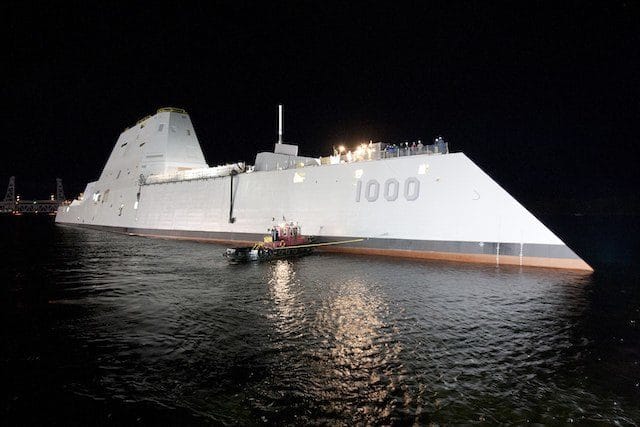
Destroyers are not always enormous, but one of the newest ships of war to enter service in the United States is a truly gigantic example of a destroyer. The USS Zumwalt is named after US Navy Admiral, Chief of Naval Operations (the youngest ever when he served), and decorated veteran Elmo Zumwalt, an American of combined Jewish American and German American heritage who is known for his anti-racism reformation work to improve personnel policies in the US Navy. The ship bearing Zumwalt’s name is extraordinarily futuristic, and the largest US Navy destroyer in history to be constructed. With its angular lines and the appearance of an ocean-going stealth aircraft, the ship will astonish first time viewers with its modernistic and angular looks.
The 610-foot vessel weighs 15,000 tons and was added to the US Naval fleet in 2016. While the new destroyer’s looks may be nothing short of bizarre among warships, the ship has stealth capacity. When seen on radar, the futuristic-looking machine appears like little more than a fishing boat in its cross-sectional appearance. The smooth, flat surface of the sections making up the exterior of this huge, guided-missile destroyer make for an unlikely UFO or spacecraft-like appearance that defines the USS Zumwalt as a most exotic ship.
6. HMS Vanguard

The largest battleship of the British Royal Navy, the HMS Vanguard was alone in her class. She held several important records among warships built worldwide, including being the fastest battleship in the Royal Navy’s fleet. The HMS Vanguard represented the most spectacular sunset work of the battleship, being the final battleship to be launched for service in Britain’s Royal Navy. The fact that this vessel was not only the largest battleship in the Royal Navy’s fleet at a gigantic 814.5 feet in length but also the fastest, despite its huge size, is a remarkable accomplishment of naval engineering.
The battleship could deploy at speeds of 30 knots, or 35 miles per hour, bringing a heavy armament to the fight with less notice than required by slower ships. The ship did not see World War II action, as she was commissioned after hostilities ended. As the last Royal Navy battleship, the HMS Vanguard was certainly in the spotlight with its status as the largest and fastest in its category, but in comparison to its great size and speed, the ship’s armament was rather average. The only battleships in Naval service worldwide that were larger were the American giant, the USS Iowa, and the huge Yamato-class battleships of the Imperial Japanese Navy. The ship is known for having transported King George VI, Queen Elizabeth, and Princess Elizabeth to South Africa in 1947. After its service, the ship was eventually scrapped in 1960.
5. Bismarck & Tirpitz

The largest German battleships ever unleashed, the infamous Bismarck and her sister vessel Tirpitz were giant members of the Kriegsmarine during World War II. Together, the sister ships formed the Bismarck-class of battleships. The Bismarck and Tirpitz represented enormous maritime might, with the Bismarck being the largest warship of Germany, with the greatest displacement of any warship deployed in the European theater of World War II. The Bismarck herself measured an incredible 823.5 feet in length, with a displacement of 55,440 tons fully loaded. The Bismarck was also wide at mid-ship, featuring a beam measuring 118 feet, 1 inch.
The warship was equipped with a total of eight 15-inch guns, set up to fire forward and backward in a set of four twin turrets. The devastating firepower of the Bismarck allowed it to sink the HMS Hood in partnership with the Prinz Eugen, following the attack of the Prinz Eugen by the Hood. Following the loss of the HMS Hood, a massive force of British Naval vessels and aircraft chased down the Bismarck. On May 27, 1941, the Bismarck was scuttled by her crew and soon sunk after sustaining an unenumerable plethora of devastating hits from British air power and naval forces. Of the 2,200 man crew, 111 were rescued by British forces, while 800 remaining survivors were left behind after a U-boat alarm prompted a retreat. The next day, two crew members were saved.
4. USS Nimitz-class
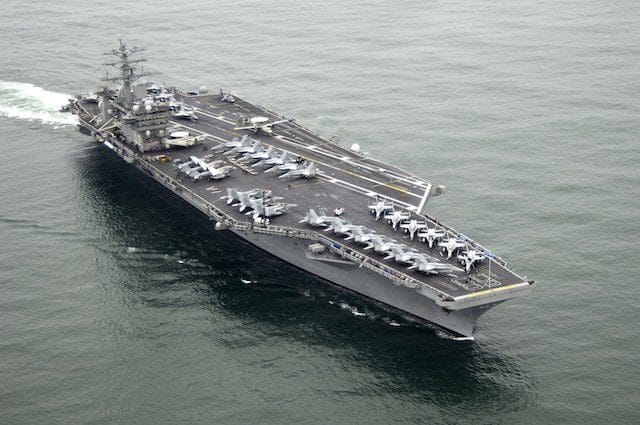
A certain ship class must hold the record among naval vessels of being the largest warships in the world at any given time, and the modern holder of that record are Nimitz-class aircraft carriers of the US Navy. An impressive 10 of these astonishingly huge vessels have been constructed, with the class in commission since 1975. Named after the famed and highly regarded US Navy Admiral Chester W. Nimitz Sr., who was born into a German American family in Texas with a grandfather who served in the German Merchant Marine and was a key mentor to the young Nimitz in his life as he pursued a US Naval career.
Nimitz became the last US Navy Fleet Admiral and held the role of Commander in Chief of the US Pacific Fleet, as well as Commander in Chief of Pacific Ocean Areas. Nimitz was also known for being the US Navy’s top submarine expert. The enormous Nimitz-class aircraft carriers named in the history-making seaman’s honor are all nuclear powered, with an enormous size of 1,092 feet in overall length and a beam width of 252 feet. With their endurance, size, power, and number, they represent an impressive and highly capable component of the US Naval might. These gargantuan warships displace 113,339.52 tons and can carry up to 130 fighter jets, or an alternative mix of aircraft. Exceptional armoring, coupled with defensive armament and the large number of aircraft, ensure the ships are well protected.
3. Kirov-class
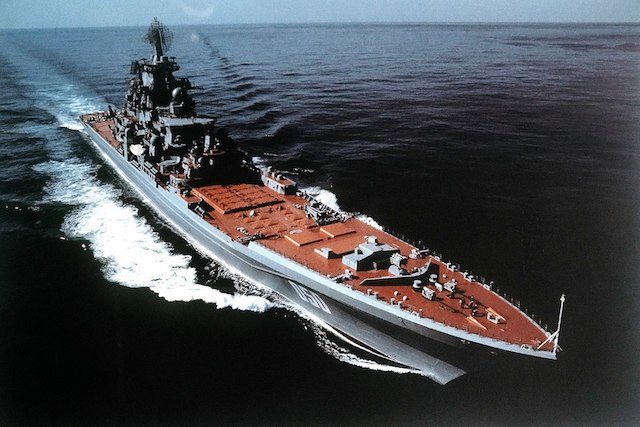
The Kirov-class represents enormous size in naval fleet equipment from Russia. Dating back to construction times between the 1970s and 1990s, the four vessels constructed are nuclear-powered battle cruisers that pack a punch with massive size, range, endurance, and armament. The huge vessels were originally to number five in their ranks, but with two being deactivated and one in the refit process, only one vessel, Pyotr Velikiy, is operation as of 2018. The Kirov-class represents the world’s largest surface combatant warship, as distinguished from ships serving as aircraft carriers or built for amphibious assault.
The appearance of the gigantic vessels on the world naval scene was enough impetus to provoke the US Navy into recommissioning the USS Iowa in response to the countering force presented to the US Navy in the form of these gigantic battlecruisers. The nuclear-powered Kirov-class ships were originally built for the Soviet Navy, and are now under the purview of the present-day Russian Navy. They stand out not only as the largest surface combatant warships in the world but also the heaviest, weighing in at a massive 28,000 tons when loaded. The ships boast a massive armament, including guns, anti-submarine missiles, anti-ship missiles, and surface to air missile (SAM) launchers.
2. Richelieu-class
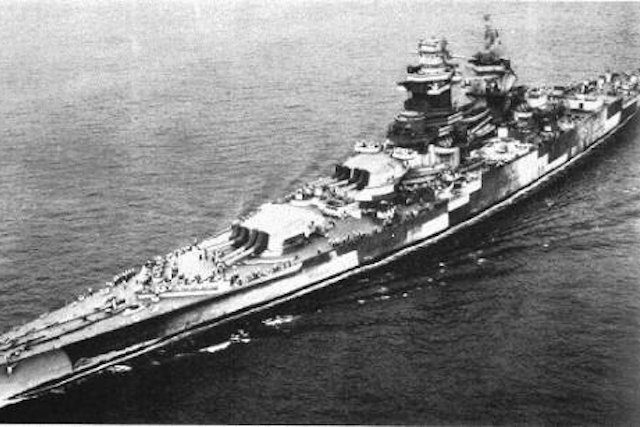
During World War II, the two Richelieu-class battleships the Richelieu and the Jean Bart were prominent as the ships comprising the largest battleship project of the French Navy… and the final one. The Richelieu operated until its scrapping in 1968, while the Jean Bart lasted two years longer, being scrapped in 1970. The ships were first operated by the Nazi puppet state Vichy France, a notorious fascist regime. Subsequently, the ships were employed in service on the Allied side of operations in World War II. The exceptionally large European vessels could reach speeds of 30 knots, or 35 miles per hour, impressive for their size.
The gigantic and heavily armed ships measured an incredible 813.2 feet in length, with a 108-foot beam. Weight standard for the Richelieu-class vessels was 35,000 tons. The monster ships ran on pressure-fired boilers and geared turbines with a set of four propellers, each having four blades. Not only was the speed and sheer size of these warships terrifying to encounter, their firepower was concentrated and deadly to face head-on. The Richelieu-class battleships were fitted with a battery of no less than eight 15-inch guns that were set up as two quad turrets that faced forward to shoot in the position of superfiring, with the top gun firing over the gun below.
1. Le Fantasque-class destroyer
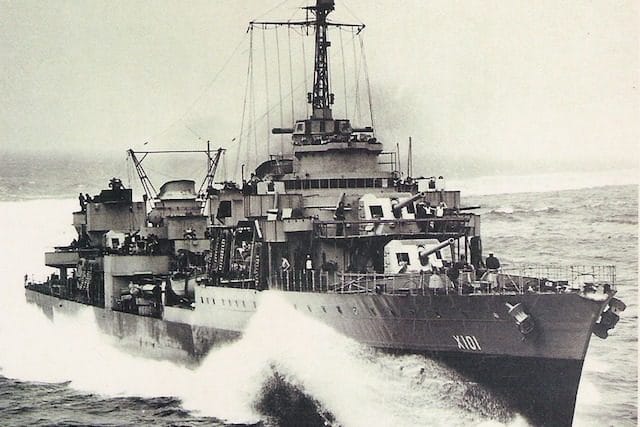
The fastest destroyer in naval history was not a modern vessel but one constructed in France prior to World War II. The Le Fantasque-class destroyers, with a name meaning “The Capricious One,” constituted a most formidable fleet of six vessels built for the French Navy and pressed into service during World War II. One would logically expect the fastest destroyer in the world to have been built by a cutting-edge naval force of the present day, but Le Fantasque-class ships were actually launched in the years 1933 and 1934.
The new class of warships proved to be a double-edged sword in World War II hostilities, serving on the side of Vichy France and also on the side of the Free French Forces in support of the Allied war effort in the European theater. Le Fantasque-class vessels boasted a lightning fast speed of 52 miles per hour, or 45 knots, gaining a notable advantage in outpacing the enemy. The size of the ships was impressive despite their need for speed, given that they measured 434 feet, 5 inches in length with a beam of 39 feet, 4 inches. Four of the powerful vessels survived World War II, two were lost, with the remaining four retired in postwar years.
4 Comments
Bismarck is a HE not a SHE …
Come on. No Dreadnought class warships on this list? I liked it, but you can’t leave something like those out!!!
Thank you for taking the time to comment.
However, this list focuses on surface vessels, not submarines, which are certainly an interesting subject in their own right!
While submarine attacks do have a real sneak attack aspect innate in their nature, barring being destroyed in a submarine attack the surface warships in this list certainly possess a variety of intimidating characteristics, be it firepower, speed, sheer size, nuclear capability or the ability to host a small air force.
There are only two types of ships in the world … submarines and targets! This list focuses on what is readily visible to the eye, but completely misses the point of the article’s title.